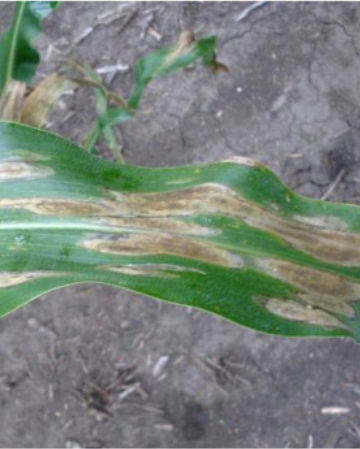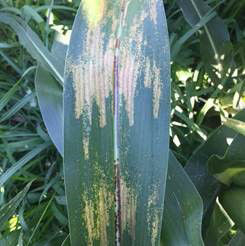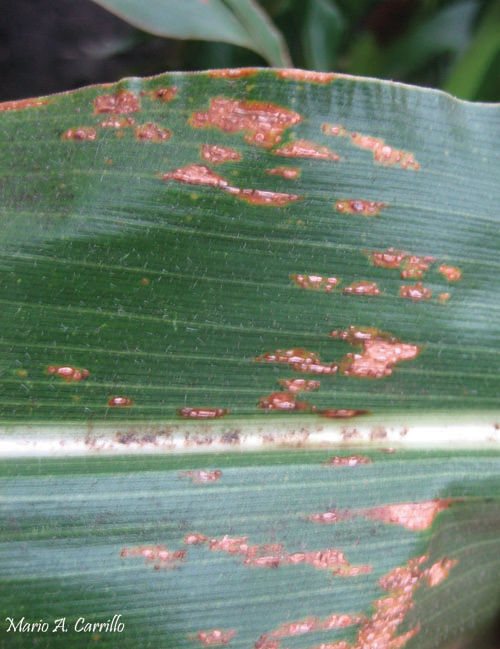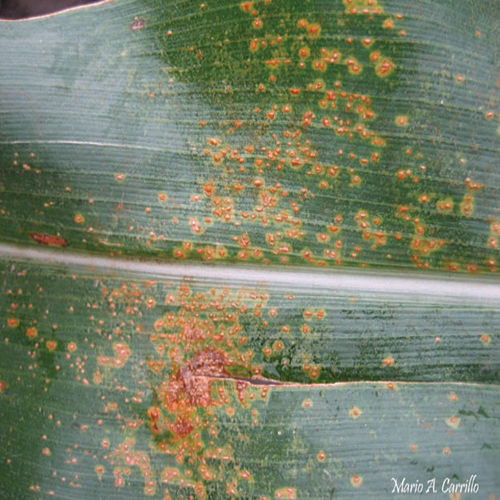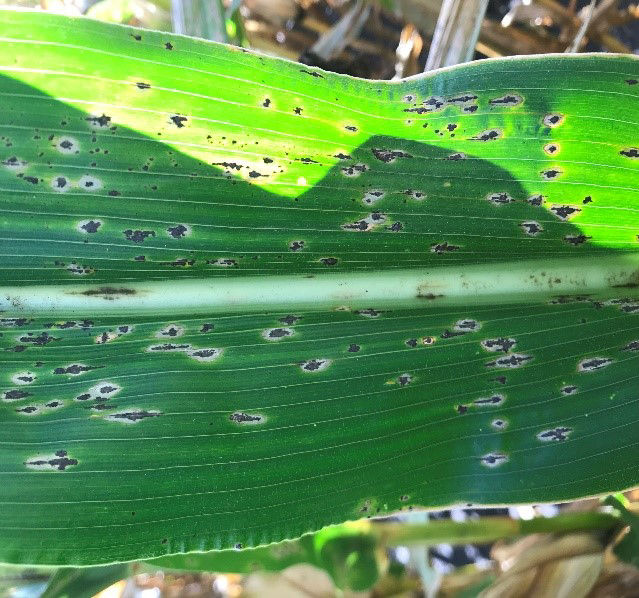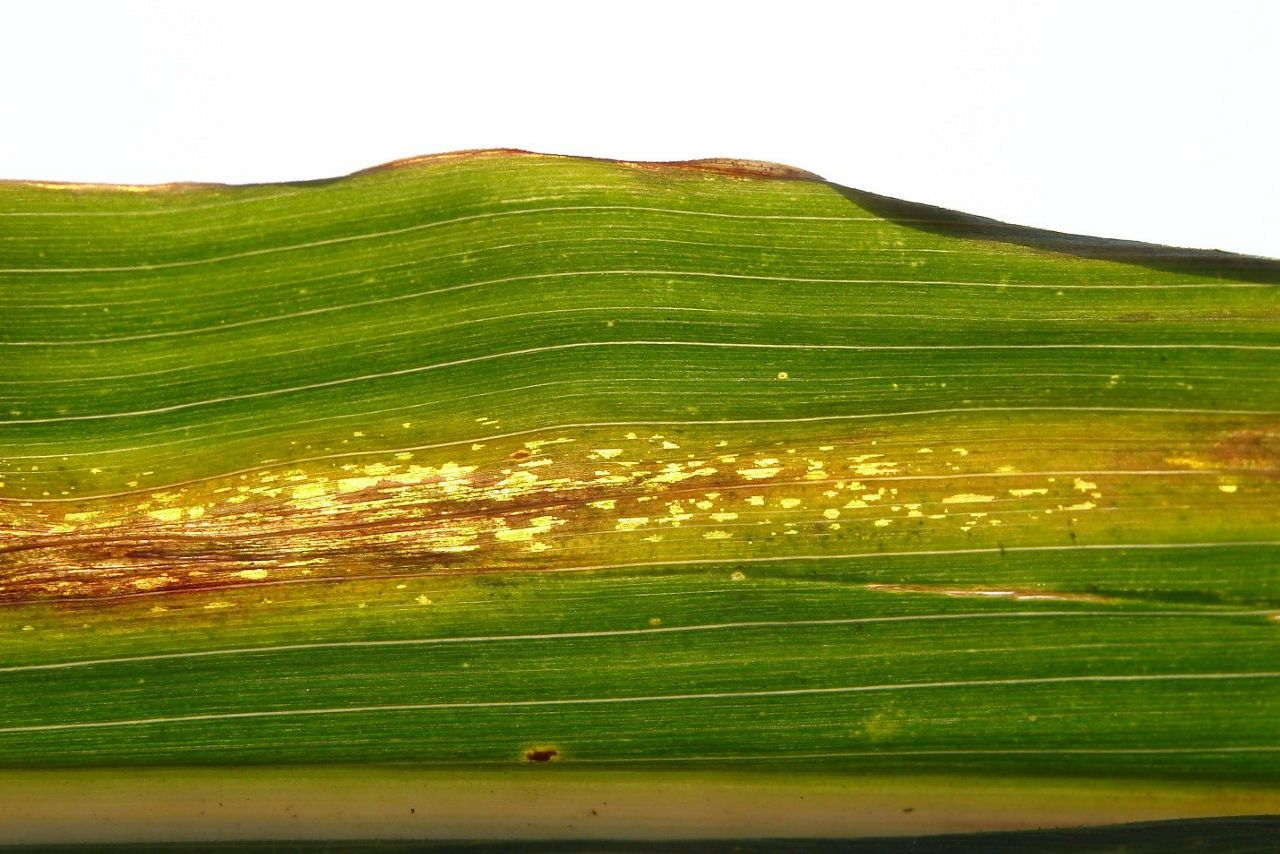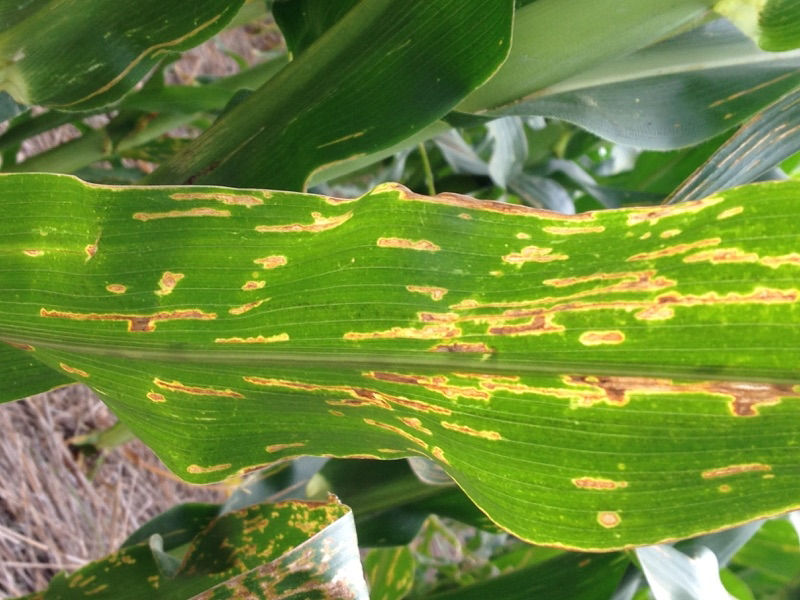15 MIN READ
Managing the Early Onset of Foliar Diseases in Corn
June 5, 2023
- Early scouting and correctly identifying an infection are key for determining the status, progression, and best management practices for foliar diseases.
All plant diseases require three components for an infection to occur: the pathogen must be present, the environment must be suitable for the pathogen, and a susceptible host plant must be available. Many sources can lead to a pathogen becoming present in a field. Depending on the disease, some pathogens may survive the winter on previously infected crop residue (e.g., northern corn leaf blight, tar spot) and some may be moved into northern growing areas on winds from southern locations (e.g., southern corn rust). For a suitable environment, many foliar diseases need warm, humid, and wet conditions to propagate. Fungal diseases (e.g., grey leaf spot) can infect and penetrate plant tissue without a wound. However, bacterial diseases (e.g., Goss’s wilt) can only infect and penetrate plant tissue via a wound to the plant. Finally, in terms of susceptibility, many Bayer seed products have been bred to have genetic resistances to many common plant diseases. Your seed provider can provide information on a corn hybrid’s susceptibility levels to many of the common foliar diseases.
When to Scout
Depending on the disease, field history, and the susceptibility of the corn product, scouting should start at the whorl or tasseling stage (Table 1). If a susceptible corn product is planted in an area with a history of foliar disease, that area should be scouted prior to tasseling to determine the presence and severity of the disease.
Table 1. Suggested sampling window, favorable environmental conditions, and management options for common foliar diseases of corn.
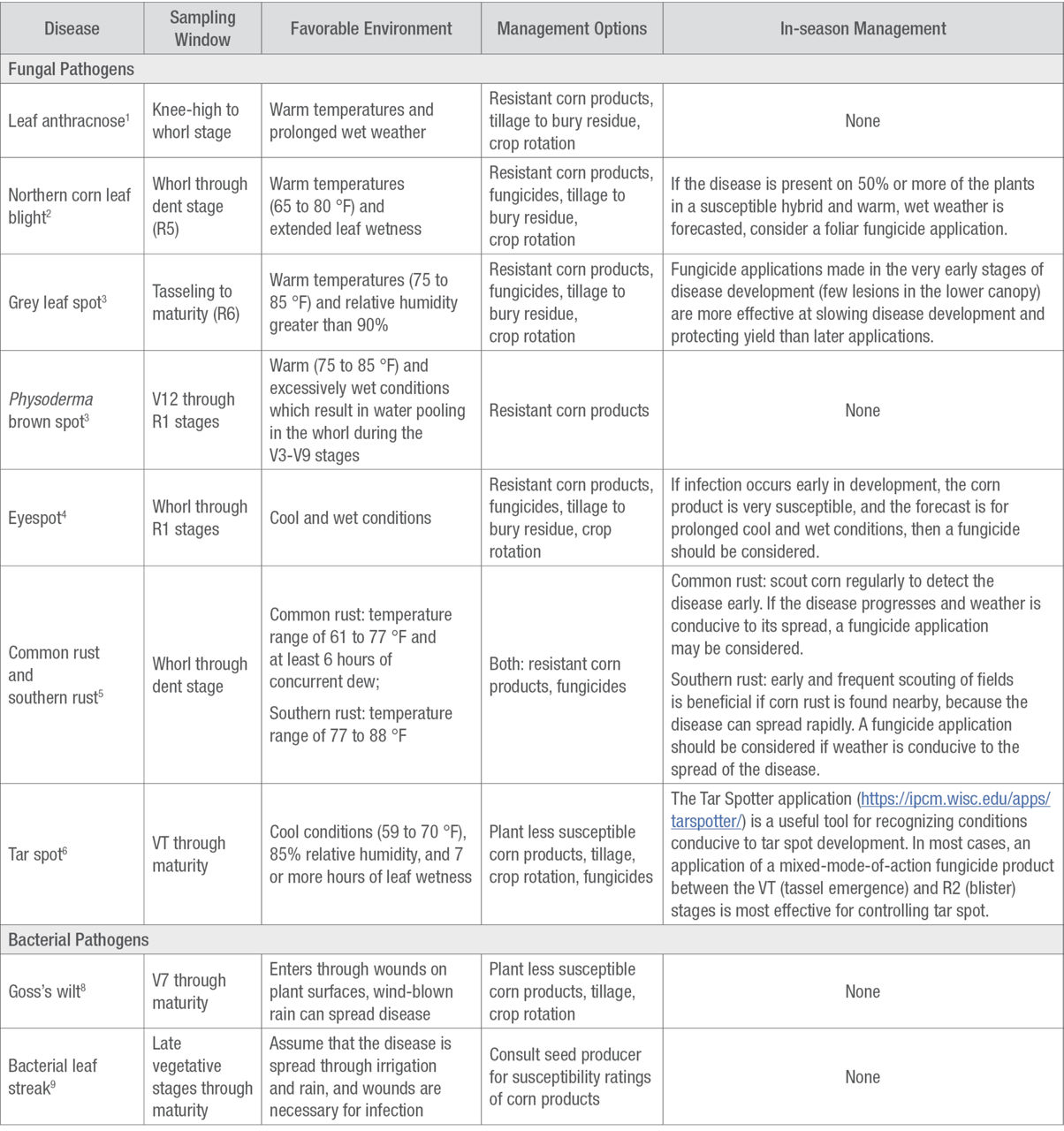
Impact on Yield and Standability
Corn foliar diseases are a concern when they develop early and progress up the plant before grain fill is complete. Disease development in corn around the tasseling stage can result in yield loss, particularly if favorable environmental conditions support the continued infection and the top 8 to 9 leaves above the ear become infected, as the photosynthetic capacity of these leaves provides at least 75% of the carbohydrates needed to complete ear fill.10 Studies conducted at Iowa State University demonstrated that when grey leaf spot and common rust were controlled using a fungicide, the incidence of stalk lodging was reduced.11
Common Corn Foliar Diseases
Fungicide Considerations12
While fungicides can help reduce the incidence of fungal diseases, they will have no effect on the bacterial diseases that infect corn. Triazole and strobilurin fungicides are labeled for corn to help manage foliar fungal diseases. Triazole fungicides interfere with fungal membrane structure and function, and must be applied preventatively or in the early stages of infection. Following application, the active ingredients in triazole fungicides move locally into the leaves on which they were applied, but they are not necessarily transported to other leaves. Strobilurin fungicides inhibit fungal respiration and should be applied preventively or as early as possible in the disease cycle. They are absorbed into the leaf and have some upward movement in the xylem. Most triazoles and strobilurins have some residual activity based on the rate of application, coverage, and environmental conditions. Consult individual product labels for harvest interval and other restrictions for use.
In most cases, fungicides should be applied at or after tasseling. For example, a fungicide has been shown to be most effective for northern corn leaf blight and grey leaf spot when applied between two weeks prior to tasseling and two weeks after tasseling.13 Follow all individual product label instructions for proper application timing, application volume, application equipment, and environmental and harvest interval precautions.
Making an Application Decision
There are many factors to consider when determining if a fungicide application is warranted. Prior to making an application, evaluate each field for the susceptibility of the corn products to the diseases, the current yield potential of each field, disease severity, and corn stage of development. Then check the weather forecast to evaluate if upcoming conditions will continue to promote disease development. Finally, consider the cost of treatment and corn price to determine if an application is likely to provide an economical return in each field.
Sources:
1Stoetzer, E. and Robertson, A. 2019. Signs of Anthracnose leaf blight on your seedlings? No need to fret! Iowa State University Extension. https://crops.extension.iastate.edu/blog/alison-robertson-ethan-stoetzer/signs-anthracnose-leaf-blight-your-seedlings-no-need-fret
2Vittetoe, R. and Robertson, A. 2016. Seeing northern corn leaf blight? Iowa State University Extension. https://crops.extension.iastate.edu/blog/alison-robertson-rebecca-vittetoe/seeing-northern-corn-leaf-blight
3Stoetzer, E. and Robertson, A. 2018. Weather conditions ripe for Physoderma brown spot and node rot and gray leaf. Iowa State University Extension. https://crops.extension.iastate.edu/cropnews/2018/06/weather-conditions-ripe-physoderma-brown-spot-and-node-rot-and-gray-leaf-spot
4Smith, D. 2015. Corn diseases of 2015 and should I spray fungicide? University of Wisconsin Extension. https://ipcm.wisc.edu/blog/2015/07/corn-diseases-of-2015-and-should-i-spray-fungicide/
5Thiessen, L., Rivera, Y.R., and Kinczyk, J. 2018. Corn rusts: Common and southern rust. North Carolina State University Extension. https://content.ces.ncsu.edu/corn-rusts-common-and-southern-rust
6Telenko, D. and Creswell, T. 2019. Tar spot. Purdue University Extension. BP-90-W. https://www.extension.purdue.edu/extmedia/BP/BP-90-W.pdf
7Bradley, C.A., Mehl, K., and Pfeufer, E. 2017. Stewart’s wilt of corn. University of Kentucky Extension. PPFS-AG-C-04. https://plantpathology.ca.uky.edu/files/ppfs-ag-c-04.pdf
8Wise, K., Ruhl. G., and Creswell, T. Goss’s bacterial wilt and leaf blight. Purdue University Extension. BP-81-W. https://www.extension.purdue.edu/extmedia/bp/BP-81-W.pdf
9Stoetzer, E. and Zaworski, E. 2018. Identifying, scouting and management of bacterial leaf streak. Iowa State University Extension. https://crops.extension.iastate.edu/cropnews/2018/07/identifying-scouting-and-management-bacterial-leaf-streak
10Rees, J.M. and Jackson, T.A. 2008. Gray leaf spot of corn. University of Nebraska Extension. G1902. http://extensionpublications.unl.edu/assets/pdf/g1902.pdf
11Robertson, A., Abendroth, L., and Elmore, R. 2007. Yield responsiveness of corn to foliar fungicide application in Iowa. Iowa State University Extension. Integrated Crop Management News 498(26): 281-285. https://crops.extension.iastate.edu/encyclopedia/yield-responsiveness-corn-foliar-fungicide-application-iowa
12Smith, D. 2020. Field crops fungicide information. University of Wisconsin-Madison. https://badgercropdoc.com/field-crops-fungicide-information/ and https://ipcm.wisc.edu/blog/2020/07/fungicide-for-field-crops-information-updated/
13Smith, D. 2018. Late season corn foliar disease update and hail damaged corn. University of Wisconsin-Madison. https://ipcm.wisc.edu/blog/2018/08/late-season-corn-foliar-disease-update-and-hail-damaged-corn/

